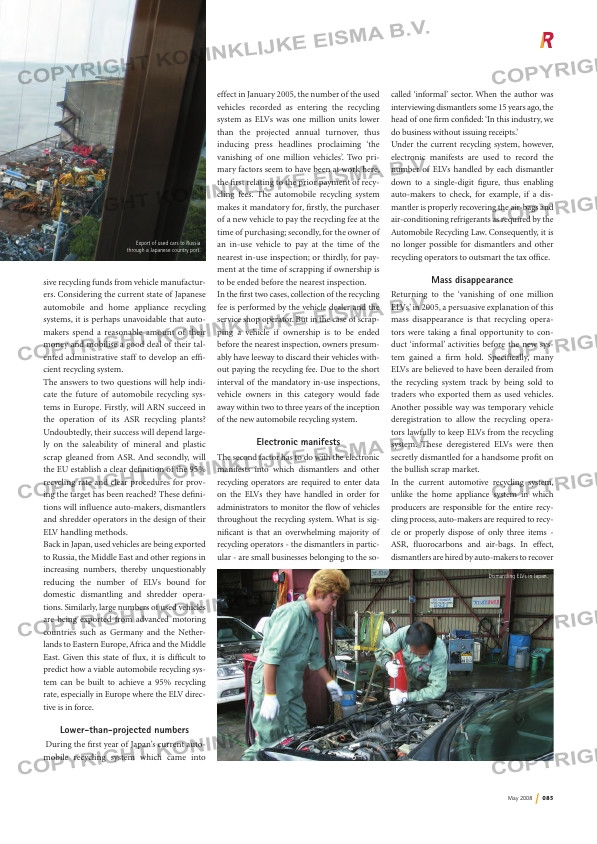Page 85 from: May 2008

May 2008 085
sive recycling funds from vehicle manufactur-
ers. Considering the current state of Japanese
automobile and home appliance recycling
systems, it is perhaps unavoidable that auto-
makers spend a reasonable amount of their
money and mobilise a good deal of their tal-
ented administrative staff to develop an effi-
cient recycling system.
The answers to two questions will help indi-
cate the future of automobile recycling sys-
tems in Europe. Firstly, will ARN succeed in
the operation of its ASR recycling plants?
Undoubtedly, their success will depend large-
ly on the saleability of mineral and plastic
scrap gleaned from ASR. And secondly, will
the EU establish a clear definition of the 95%
recycling rate and clear procedures for prov-
ing the target has been reached? These defini-
tions will influence auto-makers, dismantlers
and shredder operators in the design of their
ELV handling methods.
Back in Japan, used vehicles are being exported
to Russia, the Middle East and other regions in
increasing numbers, thereby unquestionably
reducing the number of ELVs bound for
domestic dismantling and shredder opera-
tions. Similarly, large numbers of used vehicles
are being exported from advanced motoring
countries such as Germany and the Nether-
lands to Eastern Europe, Africa and the Middle
East. Given this state of flux, it is difficult to
predict how a viable automobile recycling sys-
tem can be built to achieve a 95% recycling
rate, especially in Europe where the ELV direc-
tive is in force.
Lower-than-projected numbers
During the first year of Japan’s current auto-
mobile recycling system which came into
effect in January 2005, the number of the used
vehicles recorded as entering the recycling
system as ELVs was one million units lower
than the projected annual turnover, thus
inducing press headlines proclaiming ‘the
vanishing of one million vehicles’. Two pri-
mary factors seem to have been at work here,
the first relating to the prior payment of recy-
cling fees. The automobile recycling system
makes it mandatory for, firstly, the purchaser
of a new vehicle to pay the recycling fee at the
time of purchasing; secondly, for the owner of
an in-use vehicle to pay at the time of the
nearest in-use inspection; or thirdly, for pay-
ment at the time of scrapping if ownership is
to be ended before the nearest inspection.
In the first two cases, collection of the recycling
fee is performed by the vehicle dealer and the
service shop operator. But in the case of scrap-
ping a vehicle if ownership is to be ended
before the nearest inspection, owners presum-
ably have leeway to discard their vehicles with-
out paying the recycling fee. Due to the short
interval of the mandatory in-use inspections,
vehicle owners in this category would fade
away within two to three years of the inception
of the new automobile recycling system.
Electronic manifests
The second factor has to do with the electronic
manifests into which dismantlers and other
recycling operators are required to enter data
on the ELVs they have handled in order for
administrators to monitor the flow of vehicles
throughout the recycling system. What is sig-
nificant is that an overwhelming majority of
recycling operators – the dismantlers in partic-
ular – are small businesses belonging to the so-
called ‘informal’ sector. When the author was
interviewing dismantlers some 15 years ago, the
head of one firm confided: ‘In this industry, we
do business without issuing receipts.’
Under the current recycling system, however,
electronic manifests are used to record the
number of ELVs handled by each dismantler
down to a single-digit figure, thus enabling
auto-makers to check, for example, if a dis-
mantler is properly recovering the air-bags and
air-conditioning refrigerants as required by the
Automobile Recycling Law. Consequently, it is
no longer possible for dismantlers and other
recycling operators to outsmart the tax office.
Mass disappearance
Returning to the ‘vanishing of one million
ELVs’ in 2005, a persuasive explanation of this
mass disappearance is that recycling opera-
tors were taking a final opportunity to con-
duct ‘informal’ activities before the new sys-
tem gained a firm hold. Specifically, many
ELVs are believed to have been derailed from
the recycling system track by being sold to
traders who exported them as used vehicles.
Another possible way was temporary vehicle
deregistration to allow the recycling opera-
tors lawfully to keep ELVs from the recycling
system. These deregistered ELVs were then
secretly dismantled for a handsome profit on
the bullish scrap market.
In the current automotive recycling system,
unlike the home appliance system in which
producers are responsible for the entire recy-
cling process, auto-makers are required to recy-
cle or properly dispose of only three items –
ASR, fluorocarbons and air-bags. In effect,
dismantlers are hired by auto-makers to recover
Export of used cars to Russia
through a Japanese country port.
Dismantling ELVs in Japan.
RI_012_CAR RI_Japan.indd 3 14-05-2008 13:50:31



